


© Wonders of World Engineering 2014-


An enormous feat of engineering was involved by the building of the largest graving dock in world, at Southampton on a site reclaimed from the sea. Named the King George V Dock, it is large enough to accommodate a vessel of 100,000 tons
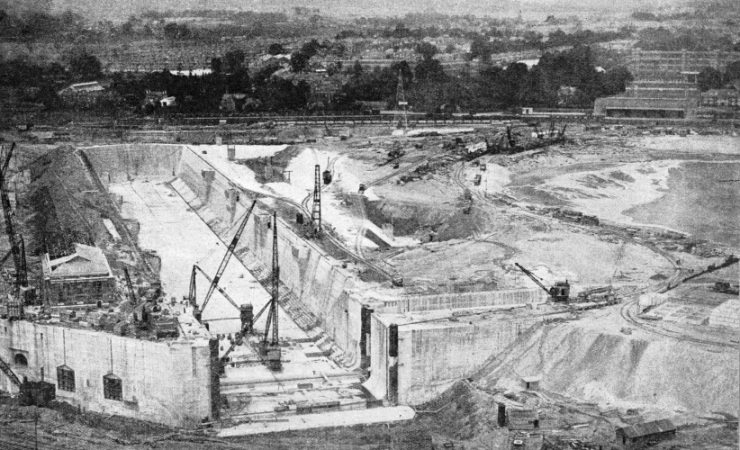
WORK IN PROGRESS on the huge basin of the King George V Dock at Southampton. From the site of the dock about 1,258,000 cubic yards of material were removed. The material was composed mainly of gravel which was used in making the concrete walls and floor of the dock.
ADMITTEDLY the proper place for a ship is floating in the water; but she may not remain floating indefinitely. Collisions and groundings cause damage below the waterline, great gales play havoc with plating and rudders, and propellers often become damaged through striking submerged wreckage. Again, a quadruple-
Plating, rudders, propellers and barnacles cannot be dealt with under water. The ship, even the Queen Mary, must be landed high and dry: hence the graving (or scraping) dock. Its operation is simple: the dry dock is flooded, the ship enters and the dock gates are closed. Then the water is pumped out again and the vessel is left poised on a long line of keel blocks.
There are thousands of graving docks spread throughout the ports and harbours of the world, but the greatest of them all is at Great Britain’s south coast port, Southampton. The King George V Graving Dock at Southampton is capable of accommodating a vessel of 100,000 tons; the Queen Mary has a gross tonnage of 80,773, so that a handsome margin has been allowed for development in shipbuilding. The dock is 1,200 feet long, 135 feet wide at the entrance and between buttresses, and 59½ feet high from floor to “cope” -
The King George V Dock was intended to complete the Southern Railway’s vast dock scheme at Southampton. This scheme comprised a 7,000-
the monoliths to help them sink under their own weight. The new quay wall gives accommodation for eight of the largest liners at any state of the tide. At the western end of the quay wall the graving dock was built.
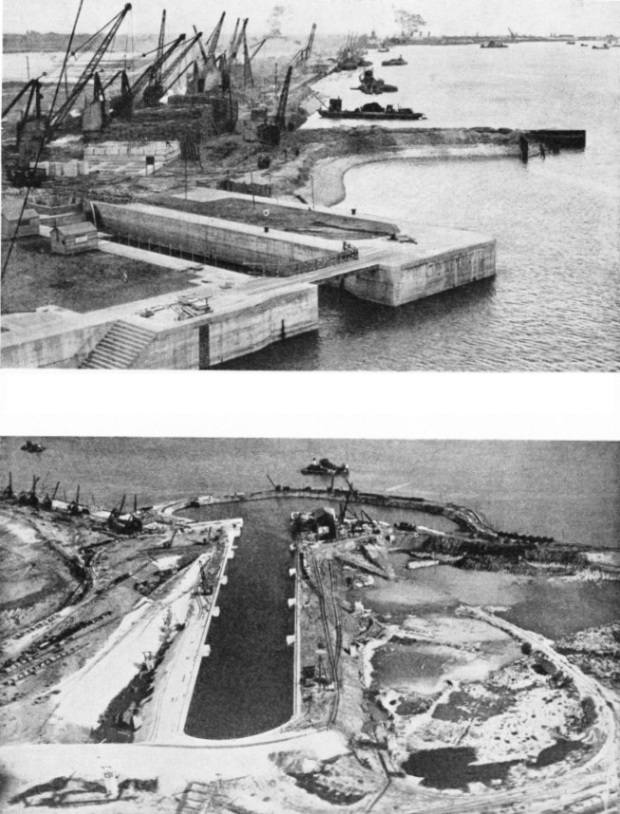
THE CAISSON “CAMBER”, or cavity, of the King George V Graving Dock, at Southampton, was excavated at the eastern side of the dock entrance. The dock is closed by a huge steel caisson. To open the dock the caisson is moved into the camber along steel runways. In the background is the line of the new quay wall and embankment which has reclaimed a considerable area from the sea and has added nearly 7,500 feet to the length of quays at Southampton.
BEHIND AN EARTHEN EMBANKMENT the reclaimed area was pumped dry and the huge graving dock built. When the dock was completed the embankment which covered the entrance to the dock was dredged away and the dock was open to the sea.
The site of the world’s largest graving dock was once a mud flat, swept for centuries by the tides of Southampton Water. The first task confronting the engineers was to win back the land from the sea. The whole area of the dock site was enclosed by an embankment of gravel and chalk. The gravel was obtained during the dredging of the deep-
Below the mud, however, was good gravel and, with this material on board, the bottom-
The transporter, appropriately named the Bankwell, was a strange looking craft and comprised two pontoons joined together by an overhead framework carrying bucket dredger gear. Between the pontoons there was enough room to accommodate a barge loaded with material. The barge was unloaded by the buckets of the dredger gear and the gravel was deposited on a travelling endless belt which was carried on a long steel boom.
The arm projected over the side of the Bankwell so that at all states of the tide it was possible to drop gravel on to the ever-
To protect the embankment from the action of the tides, the seaward slope was covered with a temporary layer of brushwood made up in bundles known as fascines. A gravel and chalk embankment will not render an enclosed area proof against the tides, as some water is bound to seep through.
To overcome this difficulty a continuous sheet of steel plate piling was driven deep down along the centre line of the earthwork. During the building of the embankment, however, it was necessary to allow the tides to ebb and flow over the enclosed area. Special sluices were therefore left in the piling, but these, on completion of the embankment, were closed by timber doors.
Problem of Artesian Water
By June 1931 the great earthen wall was completed and the engineers turned their attention to getting rid of the water covering the enclosed land. For this purpose several float pumps were installed on the embankment. Each power-
With these pumps, automatically adjusting themselves to varying water levels, the dock site was pumped dry in ten days. The water pumped amounted to 50,000,000 gallons. This, however, was only surface water. The really troublesome water lay deep underground and energetic measures had to be adopted to deal with it.
The top layer of soft alluvial mud was removed by steam navvies and a sump was made at the south end of the dock to drain off seepage water. Once excavation had begun the problem of the underground water had to be tackled. It was discovered that below the dock site there existed a bed of sand charged with artesian water at high pressure.
To relieve this pressure, and to prevent the water from bursting through an upper level of clay into the excavations, numerous tube wells were sunk into the sand. Inside the wells were placed pipes, perforated at their lower ends. The perforations were covered with copper gauze filters which permitted the passage of water but excluded the sand.
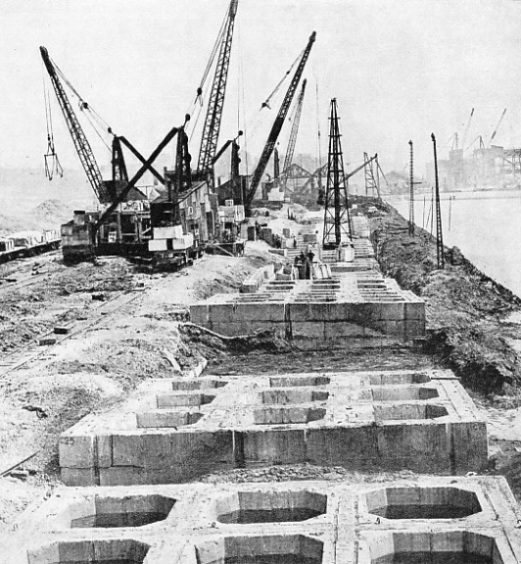
THE NEW QUAY WALL at Southampton reclaimed a large area from the sea. At the western end of this area the graving dock was built. Foundations for the wall consisted of huge concrete monoliths which were sunk by their own weight and by the operation of grabs which worked in the shafts that were left open in the monoliths.
Pumps, driven by special electric motors capable of working under water, were lowered down the pipes, and the water was thus extracted from the sand. The pressure head of the artesian water was reduced by 90 feet.
After the removal of the mud, and with precautions duly taken against inroads of water from below, the mechanical excavators made a combined onslaught against the vast mass of soil and gravel. The great walls of the dock were sunk in trenches measuring 43 feet wide and 53 feet deep. About 1,258,000 cubic yards of material were excavated from the dock site.
The gravel excavated proved of immense value for making the concrete used in building the walls and floor of the dock. Special plant was devised for washing the gravel, as well as for mixing it into concrete. This concrete-
Gravel for concrete making must be clean and free from soil. The excavated material was therefore washed in two huge revolving drums, and the clean gravel was transferred by an inclined conveyer belt to storage bins above the concrete mixer. The mixed concrete was loaded into bottom-
The remainder of the spoil from the excavations was loaded by the mechanical navvies into railway trucks and tipped where required over the reclaimed area to raise the level of the ground. The quantity, of concrete placed in the walls and floor of the dock amounted to 456,000 cubic yards. As much as 10,000 cubic yards of concrete a week were required at one stage of the work.
The concrete floor of the dock is 25 feet thick. This gigantic slab of concrete, 200 feet wide outside the walls and 1,200 feet long, serves the double purpose of carrying the world’s largest liners on its upper surface and of holding down the great pressure of the artesian water below. The relief wells referred to above were not filled in as the walls rose. The pumps were removed, one by one, and the wells were connected by horizontal drains to the dock, discharging at a distance of 40 feet below the quay.
At the shore end the dock wall is rounded in an impressive curve which, with its terraced steps, or offsets, as they are called, gives a vivid impression as of some ancient arena. Down the face of this great concrete cliff run two opposed flights of stairs, over which tower from time to time the bows of the world’s greatest ships.
The outward sloping walls of the graving dock recall medieval ramparts. At intervals of 200 feet along the dock sides are vertical buttresses resembling watch-
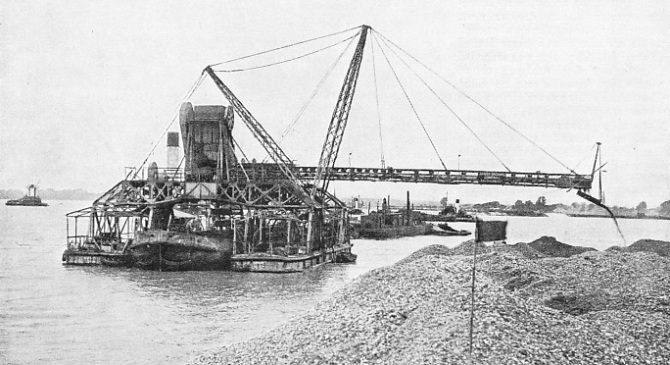
THE TRANSPORTER which deposited dredged material to form the wall enclosing the area reclaimed at Southampton. The vessel, named the Bankwell, consisted of two pontoons connected by an overhead framework carrying bucket dredger gear. Between the pontoons was room for a bargeload of material, which was scooped out by the buckets and carried on a travelling endless belt along a steel boom to the embankment.
To seal the great dock against the sea it was decided to use a huge steel wall. This took the form of a caisson, an immense rectangular steel box, built ship fashion and divided into a number of separate compartments. The caisson, which is 138 ft 6-
The caisson has five decks. Above the bottom deck (or keel plating) is a water ballast tank. The deck next above contains auxiliary air chambers that give buoyancy. Above this deck are another air chamber and additional ballast tanks. The top compartment is “free-
The total weight of the caisson, including the water ballast (except that in the free-
To accommodate this enormous gate, a cavity or “camber” was excavated at the eastern side of the dock entrance. The caisson is drawn out of the camber across the entrance to close the dock, and the meeting faces are of greenheart, a hard West Indian wood. If required, the caisson can be floated out of the camber, away from the entrance, and placed against a granite stop outside its usual position. It is then possible to repair the caisson or the other inner stops. An electrically-
The machines capable of pumping out the contents of the dock in four hours are four 54-
Ships in dry dock cannot draw water from the sea to operate their auxiliary condensers, and at the King George V Dock the difficulty has been overcome by providing three special electric pumps in the pumping station. For similar reasons the pumping station is equipped with turbine fire pumps to deal with any outbreak on board a ship deprived temporarily of her own fire-
The pumping plant is all housed in a pump room on the west side of the dock close to the entrance. In addition to this station there is also a smaller pump room at the eastern end of the dock estate for getting rid of storm water.
All pumps are fitted with special valves so that they may be isolated for repairs or for overhaul. The discharge sluice valve of every main pump closes automatically should the pump stop for any reason.
The main pumping culverts set within the concrete walls of the dock are 10 feet in diameter, and the storm water culverts measure 6 ft 6-
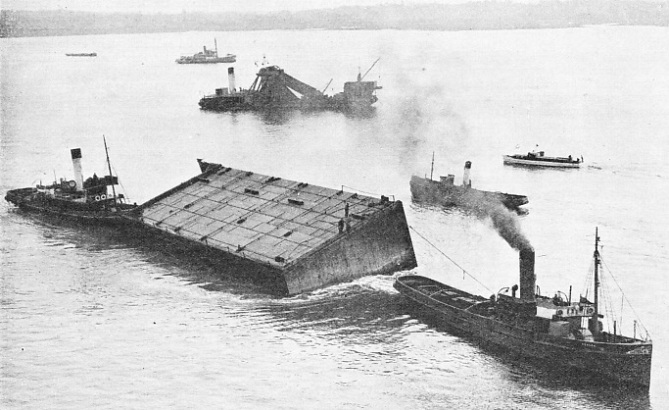
TOWING THE GIGANTIC CAISSON which forms the gate of the King George V Dock, Southampton. The caisson was built on the River Tees and towed round the coast to Southampton Water. The caisson is 138 ft 6-
This desk is 12 feet long and is divided into six panels. Four panels contain the equipment that controls the four main pump motors with their relative auction and discharge valves. The fifth panel controls the gear that operates the main sluice valves and the remaining panel carries the controls of two electrically-
The valve control panel is equipped with a selector relay system that enables whole groups of valves to be “set” for any given pumping operation by the throwing of only one switch.
The selector relay system of the valve control panel is provided with special interlocking gear which obviates any possibility of an accidental switching by the operator at the desk.
In the control room is also a large indicator board equipped with coloured lights so that the operator at the control desk can tell at a glance exactly which pumps are working and whether the sluice valves are open, shut or in motion. Each of the main valves is represented on the indicator board by a group of four lamps arranged in a vertical line. The upper two lamps are red, the lower pair green. When a valve is fully open the red lamps glow brightly, but immediately the valve begins its downward journey in closing the sluice the top red lamp goes out. Next, as the huge valve sinks lower, the second red lamp goes dim, and at the same time the uppermost of the green lamps begin to glow.
Marvels of the Control Room
As the valve lowering is continued, the top green light gains in intensity and the light of the lower red lamp is simultaneously diminished. Then, when the valve has been driven home and the sluice is shut off, the lower red lamp is extinguished and the lower green lamp is automatically switched on. Two green lamps thus remain alight to indicate that the valve is shut. A reverse indication is given when the valve is opened.
There are three 7-
The dock is equipped with two electric travelling cranes on either side. On the west side of the dock the crane has a capacity of 50 tons, with two auxiliary hoists each capable of lifting 10 tons. The 50-
In addition to the cranes a 30-
When the labours of 1,000 men for twenty-
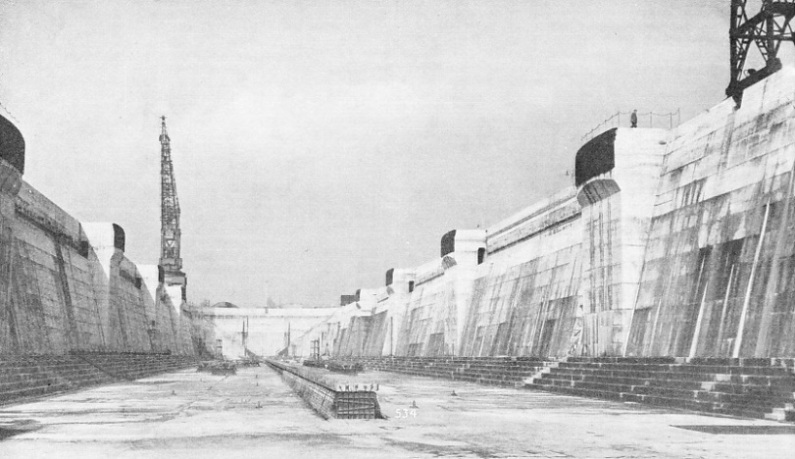
KING GEORGE V GRAVING DOCK with keel blocks In position. Vessels of up to 100,000 tons may use this graving dock, which is 1,200 feet long, 135 feet wide at the entrance and between buttresses, and 59 ft 6-
[From part 18, published 29 June 1937]
Click here to see the Photogravure Supplement to this article.